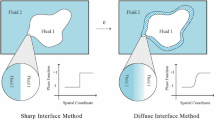Abstract
We study a conceivable two-fluid system with a layer of one fluid between a solid support and a semi-infinite layer of the other fluid in which the molecular van der Waals (vdW) forces act like gravity in well-studied cases with similar spatial arrangements. The solid support consists of two layers so that vdW forces are, similar to the gravity systems (GS), finite at the solid–fluid interface. In this Part 1, we focus on the Young–Laplace (YL) equilibrium drops of the “light” liquid with a zero angle between the solid–fluid and fluid–fluid interfaces and compare them with the YL drops in the analogous GS. We point out that there is essentially just a single GS, in contrast to a continuum of vdW systems corresponding to different values of a dimensionless Hamaker constant (DHC). We find that when the latter is above a certain threshold value, the YL drop volume cannot exceed a certain terminal value, just as it is known to be the case for GS. In contrast, in vdW systems with the smaller DHC, the YL drops may have arbitrarily large volumes, which is a major difference from GS. We introduce a certain “non-classical particle” kinetic energy and a corresponding generalized phase plane. These “energy” considerations predict interfaces with vertical tangents, which are in an excellent agreement with equilibrium drop interfaces found by numerical continuation methods. For small DHC, numerical simulations on a neutral-wave-long interval confirm the lubrication-approximation evolutions from initially flat films toward the—perpetually approached—equilibrium YL drops of the same volume. We point out that the evolution for larger DHC may be approached by the boundary integral methods suitable for the Stokes flows, which we will further investigate in the future Part 2 of this work.





























Similar content being viewed by others
References
De Gennes P-G (1985) Wetting: statics and dynamics. Rev Mod Phys 57(3):827–863
Pitts E (1973) The stability of pendent liquid drops. Part 1. Drops formed in a narrow gap. J Fluid Mech 59(4):753–767
Yiantsios SG, Higgins BG (1989) Rayleigh–Taylor instability in thin viscous films. Phys Fluids A 1(9):1484–1501
Babchin AJ, Frenkel AL, Levich BG, Sivashinsky GI (1983) Flow-induced nonlinear effects in thin liquid film stability. Ann N Y Acad Sci 404:426–427
Faybishenko B, Babchin AJ, Frenkel AL, Halpern D, Sivashinsky GI (2001) A model of chaotic evolution of an ultrathin liquid film flowing down an inclined plane. Colloids Surf A 192(1):377–385
Williams MB, Davis SH (1982) Nonlinear theory of film rupture. J Colloid Interface Sci 90:220–228
Seemann R, Herminghaus S, Jacobs K (2001) Gaining control of pattern formation of dewetting liquid films. J Phys 13(21):4925–4938
Mitlin VS (1993) Dewetting of solid surface: analogy with spinodal decomposition. J Colloid Interface Sci 156(2):491–497
Pototsky A, Oron A, Bestehorn M (2019) Vibration-induced floatation of a heavy liquid drop on a lighter liquid film. Phys Fluids 31(8):087101
Hammond PS (1983) Nonlinear adjustment of a thin annular film of viscous fluid surrounding a thread of another within a circular pipe. J Fluid Mech 137:363–384
Hindmarsh AC, Brown PN, Grant KE, Lee SL, Serban R, Shumaker DE, Woodward CS (2005) SUNDIALS: suite of nonlinear and differential/algebraic equation solvers. ACM Trans Math Softw (TOMS) 31(3):363–396
Doedel EJ, Champneys AR, Dercole F, Fairgrieve TF, Kuznetsov YA, Oldeman B, Paffenroth RC, Sandstede B, Wang XJ, Zhang CH (2007) AUTO-07P: continuation and bifurcation software for ordinary differential equations. Tech Rep
Blyth MG, Pozrikidis C (2004) Effect of surfactants on the stability of two-layer channel flow. J Fluid Mech 505:59–86
Pozrikidis C (1992) Boundary integral and singularity methods for linearized viscous flow. Cambridge University Press, Cambridge
Author information
Authors and Affiliations
Corresponding author
Additional information
Publisher's Note
Springer Nature remains neutral with regard to jurisdictional claims in published maps and institutional affiliations.
Appendix A: Relation between energy and area
Appendix A: Relation between energy and area
In view of Eqs. (54), (52) and (53) (with \(x=x(h,m)\) and the subscripts h and m indicating the corresponding partial derivatives), the total energy is written as
where \(m=h_{M}\). We have also used the expression
where s(h) is the interfacial arc length, with \(s(0)=0\). Differentiating \(E_{v}\) with respect to m yields
where for the second term in the RHS, we have used Leibniz rule and the BC \(x(m,m)=0\)., and we have written the last term in the form of a limit since \(x_{h}\rightarrow -\infty \) when \(h\rightarrow m\) (and also when \(h\rightarrow 0\)). However, we will show that the singularities cancel and the limit in (56) turns out to be finite. With the Leibniz rule, the derivative in the last term is
where in the first term of RHS, to leading order, \((1+x_{h}^{2})^{1/2}=-x_{h}\) when \(n\rightarrow 0\), and in the second term of the RHS, the integrand \(\frac{\partial }{\partial m}[(1+x_{h}^{2})^{1/2}]=(1+x_{h}^{2})^{-1/2}x_{h}x_{hm}\), so that we can integrate by parts:
Note that \(x_{h}(1+x_{h}^{2})^{-1/2}=-1\) to leading order, both for \(h\rightarrow m\) and \(h\rightarrow 0\). Hence, the integrated part is \([x_{h}x_{m}(1+x_{h}^{2})^{-1/2}]_{h=0}^{m-n}=-x_{m}(m-n,m)+l_{m},\) where we used the BC \(x(0,m)=l(m)\). Also note that
where we have used the YL equation. As a result, there is cancellation of terms with l and \(A_{0}\) in (56), yielding
In view of the expression for the area, \(\alpha =\int _{0}^{m}(x)\mathrm{d}h,\) (and using again the BC \(x=0\) at \(h=m\)), it is clear that \(\int _{0}^{m}px_{m}\mathrm{d}h=p\alpha _{m}\). One can see also that the limit term in (57) equals zero. The latter fact follows from writing to leading order \(m-h=a(m)x^{2}\), or \(x=(m-h)^{1/2}/a^{1/2}\), where \(h=m-n\). Hence, \(x_{h}=-(m-h)^{-1/2}/a^{1/2}\) and \(x_{m}=(m-h)^{-1/2}/a^{1/2}-(1/2)(m-h)^{1/2}a_{m}/a^{3/2}\), and noting that \(a_{m}\) is finite, we find \([-x_{h}-x_{m}]_{h=m-n}=O(n^{1/2})\rightarrow 0\) when \(n\rightarrow 0\).
As a result, we arrive at
Actually, more generally, we can write
which is clear from simple physical considerations.
Rights and permissions
About this article
Cite this article
Halpern, D., Frenkel, A.L. A two-fluid arrangement with bounded van der Waals body forces. Part 1. The Young-Laplace equilibria. Differences from comparable gravity systems. J Eng Math 131, 1 (2021). https://doi.org/10.1007/s10665-021-10166-8
Received:
Accepted:
Published:
DOI: https://doi.org/10.1007/s10665-021-10166-8




